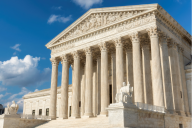You have /5 articles left.
Sign up for a free account or log in.
I have just a nip of buyer’s remorse. It’s been two months since graduation, and, stuck in unemployed Purgatory, I’ve had some time to reflect on my four years at Brown University. Most of the ingredients of a great education were present, as advertised: brilliant faculty, bright peers, lovely old campus. The aspiring journalist in me even got to indulge in an unofficial major working at the student paper. I already look back at my new alma mater with fondness.
And yet I have one big disappointment. Brown’s president, Ruth Simmons, simply did not -- with one important exception -- engage my peers and me in any meaningful way. It’s not just that Simmons was a rare presence on our close-knit campus (though she was). It’s that, six years into her term, an eloquent, almost irrationally popular university president has made precious few sallies into the public sphere. I regret that my memories of Simmons will mainly consist of the easy platitudes she delivered each year at “meet the president” receptions. It’s doubly regrettable that my disappointment probably would have been the same at any top American university.
Simmons’ general failure to challenge students -- intellectually, morally, or politically -- is all the more painful in light of the successful University Steering Committee on Slavery and Justice. This was her one coup. Simmons charged the committee in 2003 with investigating Brown’s historical ties to slavery. She commented for a much-discussed story in The New York Times and followed up with a thoughtful op-ed in The Boston Globe. Thanks to Simmons, people around the country were talking about reparations and forgotten histories of slavery. For me, first through directing coverage of the project as an editor at The Brown Daily Herald, and later through reading and commenting on the committee’s 100-page report, the experience was among the most intellectually fulfilling I had at Brown.
That was all thanks to Simmons’ willingness to wield the power of the presidency. My professors, the good ones, spoke out all the time. In one way or another, they habitually challenged students. But, next to Simmons, and the respect and media coverage she commanded, faculty voices seemed like a chorus of whimpers. Besides quietly sitting on a couple of local panels, however, and co-writing an op-ed about colleges in New Orleans post-Katrina -- neither activities aimed at undergraduates, anyway -- Simmons was not otherwise a presence in the public sphere. The inevitable corollary? She was rarely part of the personal development of students like me.
What could Simmons have done? She might have weighed in on any one of the pressing political questions of the day. (Conventional wisdom has it that she is liberal-minded, but I’m not so sure -- there’s no record to judge by.) She might have offered a fresh insight gained from decades spent in the highest academic offices. Finding time to serve on the boards of Pfizer, Texas Instruments, and Goldman Sachs, she might have pushed for corporate reform, or merely turned our attention to some aspect of capitalism in the 21st century. Above all, by words or actions, Simmons might have challenged us to stray, even a little, from the comfortable, preordained road to an Ivy League diploma. She did not.
In fairness, students bear some blame. A recent Brown Daily Herald article explored the president’s 81 percent approval rating. It conveys the disturbingly shallow nature of Simmons’ on-campus celebrity status. Students professed ignorance of the president’s duties but were full of mush about her persona. One freshman called Simmons “a power woman;” “she makes people feel empowered,” said another; and a third commented, “I feel like if you do meet her, she will hug you and make you cookies.” Students should expect their university president to be more than a wonderfully pleasant grandmotherly figure.
It speaks ill of the institutional health of the university presidency that Simmons, on paper, is the model candidate to be an engaged president. Leading Brown probably will be her final job, so caution in the service of career should be irrelevant. And as an African-American women who grew up in poverty, Simmons’ outsider perspective should leave her uniquely positioned for real engagement.
What was she spending large chunks of time doing instead? Arguably the least bold option available: stumping around in service of the university’s so-called “Boldly Brown” capital campaign. Here, the problem is systemic. Simmons is a victim. This system favors the easy currency of “prestige” -- fundraising, rapid expansion, etc. -- over what a favorite professor of mine used to call the life of the mind. As a result, presidents are caught in a cycle which will sound familiar to anyone in academia: draft blueprints for the next big project; develop a pitch; glad-hand the right parents and alums; eschew serious public engagement for fear of controversy; cut the ribbon or accept the oversized check; discover a new “need”; repeat until retirement.
There are, of course, exceptions here and there. Larry Summers, it must be said, had a knack for public engagement. When he denounced academic critics of Israel as “effectively” anti-Semitic, when he suggested that top humanities students don’t pay enough attention to the sciences and, later, when he mused on gender and scientific aptitude, at least he gave Harvard students something to think about, and in some cases, to protest. It’s too bad Summers became a victim of his own success in engagement. He challenged the university with a new perspective, they considered it -- and quickly reconsidered him. Here’s hoping his successor, Drew Gilpin Faust, does not hold back.
But by and large, Summers aside, quietism has afflicted most of our university presidents. Consider the war in Iraq. The United States invaded when I was a senior in high school and the war was a constant backdrop during my four years at Brown. But no prominent university president I can think of has uttered a critical word -- or any word, really -- about the war. Where do university presidents stand on this most important issue?
It was not always this way. The modern archetype of the engaged university president is the Rev. Theodore Hesburgh of the University of Notre Dame. During the anti-Vietnam War protests of the late 1960s, a group of undergraduates approached Father Hesburgh and asked him to pass along a peace petition to President Nixon, a personal acquaintance. But instead of delegating the matter or releasing a tepid public statement, Hesburgh responded with a counter-offer, as related by presidential scholar Stephen Nelson: the petition would be typical student protest fare, Father Hesburgh reasoned, and thus ineffective in Washington. The Notre Dame undergraduates should instead canvass the blue collar citizens of South Bend and seek 40,000 petition supporters, or roughly 80 percent of the town. Recognizing the wise counsel of a president they respected, the students accepted the challenge. Soon, they won more than 40,000 South Bend signatures and Father Hesburgh passed the petitions on to Nixon.
Father Hesburgh’s example could not be more relevant today. My own model college president is Alexander Meiklejohn. Alexander Meiklejohn: Teacher of Freedom, an introduction to the philosophy professor, First Amendment scholar, and university president should be required reading for every sitting university president in the country. After serving as a dean at Brown, Meiklejohn became president of Amherst College in 1912. A student favorite who made a point of teaching philosophy classes himself (he excelled as a seminar leader), Meiklejohn’s tenure was marked by innovation and controversy. He angered alumni by urging amateur, not professional, coaching in college athletics. He established courses, taught by both faculty and students, for workers at local mills. He made it known he wouldn’t mind having a Bolshevik on the faculty, providing that the man could teach. And before America entered World War I, Meiklejohn opposed “preparedness training” on campus.
Where are the Meiklejohns and Hesburghs today? Meiklejohn himself warned that college administrators “if they can have their way will make of life a smooth, well-lubricated meaninglessness.” That phrase pretty well sums up the state of the university presidency today. Standing atop the most prominent bully pulpits in the country, university presidents too often retreat into a safe passivity. They spend too much time stooping down, hands outstretched, wooing the next big-ticket donor. Until they learn to prod and provoke again, to truly employ their good offices, not just students will lose -- the country will too.








